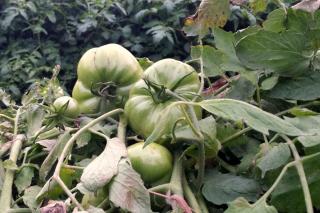

Primora tomato key facts:
Botanical name – Solanum lycopersicum
Family – Solenaceae
Type – fruit vegetable
Height – up to 6 feet (2 m)
Planting distance – 20 to 28 inches (50 to 70 cm)
Exposure – full sun
Soil – cool, rich, soft and well-drained
Planting – May
Harvest – July to September
The ‘Primora’ tomato is an heirloom tomato variety that’s famous for its savory taste. This variety produces ribbed and slightly flattened fruits, the color of which is brown with a tinge of green at the shoulder. The flesh of the primora tomato doesn’t have many seeds, and tastes a bit sweet with a soft taste that doesn’t overdo it. Ornamental, flesh that melts in the mouth, juicy, not a trace of acidity… this is a variety that children will find very appealing!
>>Read also: how to keep tomato seeds
You’ll need to sow your Primora tomatoes under cover at the beginning, with a temperature of around 68°F (20°C). Seeds should be sown in individual nursery pots, in a substrate purely prepared from sieved seedling potting mix.
Young seedlings must then be transplanted to the vegetable patch after the date of the last frost has passed. Mid-May is often a safe time to plant, but this depends on where you live. Plants must be around 5 to 6 inches tall (12 to 15 cm).
 Plant your Primora in a sunny spot that won’t get too dry in hot weather, in soil that you’ll have broken up beforehand. Space the planting holes 2 feet apart (50 cm) in rows set 2½ feet apart (70 cm).
Plant your Primora in a sunny spot that won’t get too dry in hot weather, in soil that you’ll have broken up beforehand. Space the planting holes 2 feet apart (50 cm) in rows set 2½ feet apart (70 cm).An annual vegetable plant, the Primora tomato grows outdoors from spring to fall, and has to be sown again every year. This indeterminate vine requires staking from the moment it’s planted until the season is over.
A frost-vulnerable plant, it may be necessary to grow this variety under the cover of a greenhouse or tunnel in colder regions.
The Primora tomato sadly fares no better than other Solanum lycopersicum tomatoes as regards common diseases. It hence remains vulnerable to tomato mildew and powdery mildew.
A lack of calcium in the soil may lead to a phenomenon called tomato blossom end rot.
The main pests of Primora tomato are mites, nematodes, thrips, whitefly, aphids, bollworms and leaf miners.
Primora tomato fruit must be harvested at peak maturity. Just pick a few as you need them for your own meals, anytime from July to September (which is 4 to 5 months after sowing).
The elegant, noble brown color of Primora tomatoes helps decorate summer tossed salads. However, on top of simply eating it raw, this tomato’s juicy, melting flesh makes for truly delicious baked side dishes. Perfect for stuffing and baking, or to simmer down and make delicious tomato sauces and syrups.